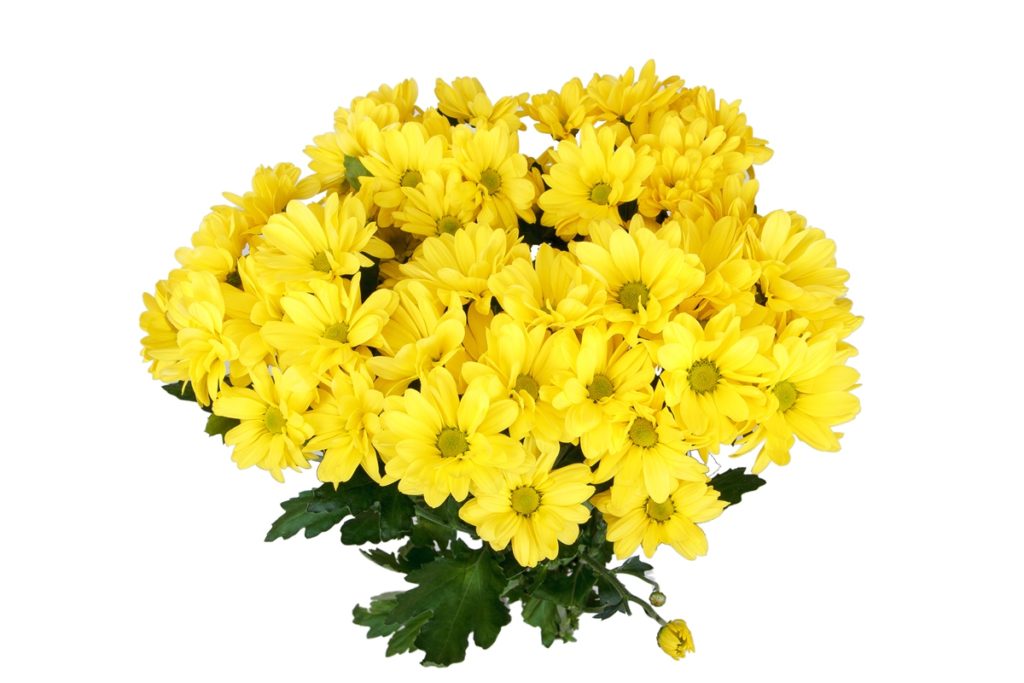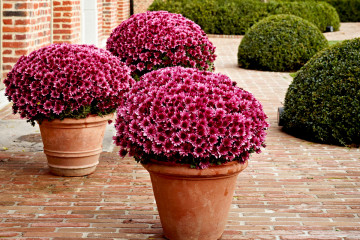Chrysanthemums white, yellow - description of species and varieties
Content:
White chrysanthemums are popular. They are often planted in the Urals in the open ground of majestic gardens, using a special cultivation technology. You can also meet them in cold Siberia. In addition, they are considered the least clichéd flowers. Therefore, a bouquet or a pot with a magnificent chrysanthemum can be given not only to a woman, but also to a man, without risking getting into an ambiguous position.
Description of species and varieties of white chrysanthemums
There are countless species and varieties of white representatives of the annual or perennial Astrov family.
Some of them:
- Chamomile. This includes "Snegurochka", "Chik", "Himalayas". They got their name due to the similarity with chamomile: a large yellow core and white petals.
- Korean large-flowered. These are "Swan", "Bear", "Poodle" and others. They look very voluminous and majestic.
- Korean multiflora. They differ in that the edges of the petals become pink during flowering: "Furor", "Belyanochka".
- Shrub: "Euro", "Coconut", "Sky" (if at the time of flowering you rub the core of the inflorescence, it will turn lemon yellow).
- Undersized: "Bonita", "Bride's Dress". Bloom in early autumn.
- Chrysanthemum White Anastasia. It belongs to the Indian variety and is distinguished by large flowers with an admixture of green.
Bacardi
Chrysanthemum Bacardi is a very elegant delicate flower. It was first presented in 2004 at a performance by singer M. Borsato. Now Bacardi is often included in bouquets-mixes of different types of flowers.
It happens not only white, but also yellow, cream, red, pale pink. Blossoms in July and blooms until the end of September. With its strong green stem, it retains its durability for a long time.
Santini
Chrysanthemum Santini is considered a mini chrysanthemum. This small-flowered variety is a small and compact shrub. Inflorescences are double, chamomile and spherical. Up to 30 flowers can open on one shrub.
Very frost-resistant species, but during wintering it needs shelter.
Multiflora
Chrysanthemum Multiflora planting and leaving is not difficult. Now this variety is presented in almost all catalogs of famous flower companies. Multiflora can be grown both in pots and outdoors.
A special feature is that the crown is naturally formed in the form of a ball. This variety was bred to decorate gardens. After Multiflora is fully blooming, even the foliage does not show through the flower ball.The height of the shrub does not exceed 40 cm, however, there are also tall specimens among the varieties.
Plants do not need to be pruned, only pinching is recommended. The disadvantage of Multiflora is considered poor frost resistance, it is not easy for her to winter in European countries.
Early varieties:
- Sunbeam Corall. Has coral flowers.
- Amor Dark Pink. The flowers are pleasant pink in color and reach 4 cm in diameter.
- Meridian Dar. Juicy, colorful, burgundy flowers of small size, up to 3 cm in diameter.
Blooming in September:
- Branroyal Yellow. The shrub has yellow flowers, its height reaches 70 cm.
- Branchili. Pleasant, creamy color of flowers, about 4 cm in diameter, 40 cm in height.
Spherical multiflora
Chrysanthemum Multiflora spherical should be properly looked after:
- Choose a good planting site with sunshine. In its absence, the shape of the shrub will be greatly distorted. Do not plant near fences, since then there will be no uniform illumination.
- Prepare the soil. In the autumn period, humus with ash should be added, then carefully dig up this area. Dig again in the spring before planting. The optimum soil composition is peat mixed with sand and turf.
Reproduction takes place using:
- Seeds,
- Escapes
- Cherenkov.
Outdoor wintering
Outdoor wintering is very risky for Multiflora, but this process is successful for some growers. To do this, you should build a good shelter yourself.
There should be no pits in the soil around the bush so that moisture does not linger in them. During a thaw, the soil will receive an excessive amount of moisture, which will cause the roots to die.
Before the shelter, the shrub is pruned so that it can fit under the canopy. The frame of the shelter is made of boards, on which the insulation is placed. The cover is removed in March-April, after the frost has receded.
Multiflora in Siberia
For Siberia, Multiflora is a rarity, since it is not able to withstand temperatures below seven degrees below zero. Even if you cover her, she will die under harsh conditions.
The only way out is to use the earliest varieties that will fade by the first frost. Then they should be placed in the shelter already in October and constantly check the wintering conditions: whether there is drying out or, conversely, waterlogging of the soil, whether there is no mold or fungus.
Yellow chrysanthemums
Yellow chrysanthemums are translated from Latin as "golden-colored". Initially, the flower had an orange, gold color, later, with the help of selection, other shades began to appear.
The Chinese are respectful of these flowers because they believe they bring good luck. The effect, in their opinion, is enhanced if they are put together with bamboo and pine. The Japanese call them "kiku" ("sun"). Kiku saves from ailments, gives a charge of longevity and beauty.
In the open field, they are able to take root with many crops:
- Plush,
- Cereals,
- Verest.
When creating a harmonious composition with a flower, you can even combine shrubs and fruit trees: apple, sea buckthorn and raspberries.
There are a lot of varieties of yellow chrysanthemum, they differ in the shapes of inflorescences, leaves and color saturation.
Alice
This early variety is Multiflora. At the beginning of flowering, Alice is covered with flowers of orange-egg color, fading, becomes reddish.
Branarktis
Branarktis lemon reaches a height of 40 cm. Lemon inflorescences are up to 5 cm in diameter.
Branindio
Branindio is a lush shrub up to 50 cm in height.
Daisy chrysanthemums
Asia became known for the first time with daisy chrysanthemums. They not only decorated gardens, but were also eaten.
They are perennial plants with umbrella-shaped inflorescences. Flowers are double and non-double.They are distinguished from the field chamomile by the larger and more spectacular flower size.
There are different shades:
- Pink,
- Purple,
- Red,
- Yellow,
- Cream.
Inga
Inga Chrysanthemum is a Korean variety. Shrub, up to 70 cm in height. The flowers are yellow in color, with tubular petals and feathery along the edges.
Camilla
Camille Chrysanthemum is a terry bush. Inflorescences with a bright yellow core reach 5 cm in diameter. Very similar to chamomile. It stands after cutting for about 6 days.
Lacemaker
Chrysanthemum Crugevnica is an unusual Korean variety. Non-double, with spoon-shaped petals. Convex yellow core. It blooms in October, the shrub rises 55-70 cm in height.
Prosseco
Chrysanthemum Prosseco is a bouquet bush. The flowers are medium-sized, milky-colored petals, the core is greenish in color, up to 6 cm in diameter. If cut, it can last 2 weeks.
Zembla
Chrysanthemum Zembla is considered a large-flowered terry beauty. It is cultivated as bush and single-headed. You can decorate the garden with Zembla, and landscape design, and a cozy home atmosphere.
In the garden, it can reach a meter in height, at home - about 30 cm. The flower petals are tongue-shaped, on one branch - up to 3-4 buds. The most popular are yellow inflorescences.
Often the word "mix" is put with the name Zembla, since it has a huge variety of varieties that differ in the outflow of petals.
Chrysanthemum keeled
The keeled chrysanthemum belongs to the groups of annual chrysanthemums, which also includes the crowned, sowing and multi-stemmed species.
Has characteristic features:
- The leaves are arranged in turn
- Fruits - in the form of achenes with a fly,
- Inflorescences in the form of a basket up to 4 cm in diameter,
- Flowering begins in June and lasts until the end of August.
Blue chrysanthemums
There is a great interest in blue chrysanthemums, both among gardeners and scientists. With the help of selection, it was possible to bring out a chrysanthemum of cream, purple, white, green colors. Blue ones can be obtained at the moment only thanks to proper planting and care.
Such an unusual color of inflorescences acquire after spraying or using food dyes.
White, creamy beige specimens are suitable for staining. Before staining, a jar is prepared, food coloring is blue or blue, water and flowers in the cut.
Scheme:
- A neat cut is made on the stem of the bush. You can't damage it.
- In the water, according to the instructions, the dye is diluted, where the cut flowers are placed.
- The staining process takes 8 to 20 hours.
Green chrysanthemums
A very rare and original species. Varieties are classified as single-headed and bush varieties.
Green beauties will add unprecedented beauty to bouquets-compositions with roses, gerberas, asters and daffodils. As a rule, they are often chosen as gifts for successful men.
There are not many varieties of green queens. The color is light green and deep, almost turquoise.
Code Green
Chrysanthemum Code Green, bred by Dutch breeders, has pompon inflorescences of malachite color. The bush will grow up to 70 cm in height and can stand up to 3 weeks in cut.
Green Lizard
The full name is Chrysanthemum Green Lizard. Also bred in Holland.
Flowers - up to 7 cm in diameter, light green color. The shrub can reach a height of one and a half meters. Keeps very well after cutting.
Rhythm
Chrysanthemum Rhythm has extraordinary inflorescences in the form of needles. The flowers reach 7-9 cm in diameter, the petals "lighten" the core due to the delicate herbal color. The height of the bush varies from 60 to 90 cm. This variety easily tolerates cold and transportation, retaining its natural pristine appearance after cutting.
Froggy
Froggy Green stands out with small ball-shaped inflorescences up to 4 cm in diameter. Froggy is often used to compose harmonious floristic compositions. Blooms in October.
You can look at three things for an infinitely long time: fire, water and ... chrysanthemums. They combine simplicity, pride, joy and beauty. The value of beautiful sunny beauties is to bring inspiration during the autumn blues, to take care of the garden beauty in winter and look forward to spring.


























